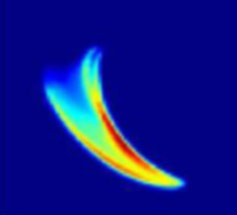

Friday - July 21, 2006
SLAC Today is
available online at:
http://today.slac.stanford.edu
In this issue:
SSRL Stirs Up a Witch's Brew
ILC Researchers Build a Communications Strategy
Economist: Reading the Invisible
 |
 |
|
Friday - July 21, 2006 |

X-ray scan of a spider fang showing concentrations of zinc (in red). SSRL Stirs Up a Witch's BrewOne might assume the presence of insects or rodents in SSRL is a situation to be altogether avoided. But this summer, beamline 6-2 is experiencing just such a visitation, if not from the vermin themselves, then from a vast number of their individual parts. No it's not a piecemeal plague, but a witch's brew of studies involving spider fangs, fruit fly heads and mouse livers. SSRL's beamline 6-2 is uniquely qualified to handle this onslaught. The x-ray microprobe housed there is a research destination to scientists from all over the world interested in taking a deeper look at the chemical make up of things, and in particular, what role certain metals play. Three of these recent studies have sought a deeper understanding of how such metals behave in some unusual organisms. Read more... |
||
|
|
||
Reading the Invisible
Archimedes of Syracuse is hailed by some as the greatest mathematician of antiquity. Ignoring a clunky numerical system and devising his own, he demonstrated the nature of infinity and calculated a value for pi. He realized that the volume of an object can be measured by how much water it displaces, a discovery he is said to have made in the bath and which caused him to run naked through the streets of the city shouting "eureka" ("I have found it"). Now, a new use for a particle accelerator is poised to reveal more of his thoughts. Starting on July 26th, researchers at the Stanford Synchrotron Radiation Laboratory in California, led by Uwe Bergmann, will attempt to read the final pages of the oldest known manuscript of Archimedes's work, the Archimedes palimpsest. Archimedes lived in the third century BC but, in the tenth century AD, a scribe copied out his works. Two hundred years later, the book of 90 pages was unbound and washed so that the goatskin parchment could be reused, producing what is known as a palimpsest, in which the older writing is sometimes visible under the new. The leaves were folded in half to produce a volume of 174 pages, and Christian prayers were inscribed in it. Forgers who added gold religious images sometime after 1930 further damaged the document. Read more in The Economist... |
ILC Researchers Build a Communications Strategy
Ask any International Linear Collider (ILC) scientist about the ILC and you'll get a number of different answers. Some will talk about its high discovery potential in basic science, others will focus on it as a "high tech" research and development center networked world-wide. Still some others consider the ILC an educational center for the next generation of world scientists. Earlier this week, about 40 participants at the 2006 Vancouver Linear Collider Workshop arrived to the conference a day early to participate in the first ILC communications seminar. There they sought to define a clear goal and message for building a consensus of support for the ILC both inside and outside the particle physics community. "There's nothing wrong with having different perspectives, yet when communicating the essence and purposes of the ILC to its audiences and stakeholders around the world, the ILC story must be clear, consistent and compelling," said Neil Calder, one of the workshop organizers. At the workshop, Barry Barish, Director of the ILC Global Design Effort, spoke on the importance of communications to the success of ILC communications and Fermilab Director of Communications Judy Jackson gave an overview of what has been achieved so far. Read more... |
Events (see all | submit)
Access (see all)Announcements
|
| | ||
|
|
||
 <%
Response.AddHeader "Last-modified", getArticleDate()
'Response.AddHeader "Last-modified","Mon, 01 Sep 1997 01:03:33 GMT"
'Monday, December 06, 2010
%>
<%
Response.AddHeader "Last-modified", getArticleDate()
'Response.AddHeader "Last-modified","Mon, 01 Sep 1997 01:03:33 GMT"
'Monday, December 06, 2010
%>View online at http://today.slac.stanford.edu/. |
||